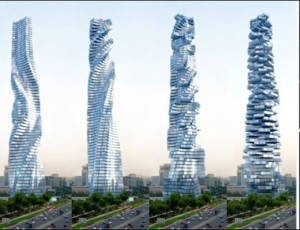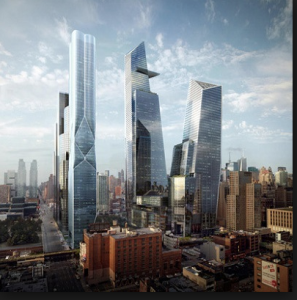And It is a Future that Sells Out Historic Districts and the Human-Scaled City
The Mayor and his deputies have been selling “affordable housing” for a while now. In a city as expensive as New York, isn’t cheap housing kind of like apple pie, something indisputably good? Well, the devil is in the details.
The problem is that a “progressive” Mayor’s office has decided to base housing policy on a flawed, Bloomberg-era ideology. It started with bombastic manifestos about “hyper-density.” Right-wing anti-regulation economist Edward Glaeser fired the first shot with his book The Triumph of the City. The “build-it-all-now” modernist architect Vishaan Chakrabarti then wrote A Country of Cities. Glaeser teaches at Harvard, blogs for Bloomberg, and is on the board of the conservative Manhattan Institute. Chakrabarti was once the Executive V.P. for mega-developer The Related Companies and remains a partner in the ubiquitous architectural firm SHoP, a firm with its paws on nearly every big project in the city. He was also Bloomberg’s Director of City Planning.
Glaeser and Chakrabarti hyped the same hyper-density program that ended up adopted wholesale by the de Blasio administration. The program will sound strangely familiar if you caught the Mayor’s State of the Union speech, the one in which he held out Co-Op City and Sty Town as housing models of the future.
Here it is, hyper-density in a nutshell, cribbed from the manifestos:
- Build very high towers everywhere – even according to the “towers in the park” model if “done right.” That’s the very model so discredited by Jane Jacobs in her classic book, The Death and Life of Great American Cities. Skyscrapers, we are told nonsensically, bombastically, and despite evidence to the contrary, raise GDP [don’t laugh, they make diagrams about that idea].
- The more towers the better. If there is not enough room for the park part, then just do a tower. Scatter them densely around the city. Don’t cluster them in particular areas like Hudson Yards or the Financial District. Remake the city as “Tower World,” like what is happening in Tribeca or along 57th Street.
- Sell this vision by imposing a rule that developers must make 20-30% of the units in these towers “affordable.” This is the Trojan Horse part. Who can object to affordable housing? Oddly, “affordable” is undefined in either of the aforementioned books. And the manifestos pointedly ignore that middle-class affordability – meaning housing for public sector union employees like police, firefighters, and teachers – can be achieved – and has been achieved – by beautiful, traditional means other than hyper-density. The model ignores that inclusionary zoning is also temporary affordability. In 10-20 years (depending on the deal), the units revert to market rate rents anyway and we are back to square one.
- Undermine or eliminate historic districts and Landmark Commissions that stand in the way of this tower-building business. The goal is Tower City, history and landmarks be damned! In fact, get rid of any regulations that annoy developers, including contextual zoning and height restrictions. After all, regulations might slow them down from building the Tower World of the Future.
- Destroy the past and let the unregulated, unfettered, free market in real estate go forth unto the city. Think big, like Hudson Yards (see photo).
- If thus freed, developers promise to create a temporary construction boom. They will invite new residents from around the world to buy the new luxury housing. This, they promise, will raise the real estate values of everyone, especially the rich, and thus allow the city to further raise real estate taxes, thus pocketing more tax revenue in a virtuous cycle. Win/win for all! Or at least the rich/rich. Their showpiece for this idea is the area around the High Line, now luxury central (meaning no disrespect to the actual High Line itself). Bloomberg’s Deputy Mayor for Economic Development had his own pet version of this theory: build the city of the rich and we can all work for them as servants in the service economy of the future.
- Let labor unions raise their arms to the heavens in happiness – literally – since they will be allowed in this model to assemble pre-fabricated modular housing made in China. (Don’t laugh, they have diagrams for this, too.)
- Cities like Paris and Barcelona– which are among the world’s most dense, beautiful, and beloved models of livable urbanism anywhere – are held in contempt as “imperialist,” “segregationist,” “historicist,” and “racist.”
- An urban model of hugely tall glass towers and densities of 800-1200 units per acre should be copied from dictatorial regimes in Hong Kong, Beijing, Dubai, and Singapore. Those models are to be honored as forward thinking, not just because they often hire SHoP Architects to design for them, but because hyper-density fans think of these places vaguely as “the future” of civilization.
- Anyone who objects to this program – in the view of the hyper-density fanatics – is deemed an ignorant, uncultured NIMBY, possibly a community activist who “misunderstands Jane Jacobs.” At the very minimum, objectors are “racist,” possibly “blue-haired,” and certainly “villainous.” The last word might be true, as the origin of “villainous” is “villein” an old word for “serf.” I guess that is what we ordinary citizens are in the hyper-density model anyway.
That’s it. That’s the model of hyper-density. The downside? It destroys forever the distinctive greatness of New York’s older mid-rise neighborhoods, all for an elusive “fix” for the affordable housing problem. Yet the 80/30 fix is also temporary while the loss of light and air and beauty is forever.
It should be obvious to all now that this kind of vision for the city will only result in “The Triumph of Big Real Estate,” not the triumph of affordable housing or a livable city. The hyper-density vision imposes a false trade-off, that to get affordable housing, we have to damage the historic, mid-rise city. That trade-off is false and without economic foundations.
What then is to be done? A first step is to rethink the issue conceptually by separating affordable housing from hyper-density. They are two different problems.
Also, a better vision for affordable housing requires us to look around more empirically. New York City lost 256,000 rent stabilized apartments since 1994. Much of that loss happened in historic districts. So to be smart, the first thing to do is just plug that hole without delay. Of course, the cynical reader might think: can we do that since Big Real Estate never wants to strengthen rent-stabilization? Big Real Estate has fought down tenant protections for years. That reader would be right. But why give up on democracy just because Big Real Estate is in the way?
Another thing to do is to work with developers and architects who know how to build livable neighborhoods with mid-rise buildings that face the street, just like the great European cities so held in contempt by the hyper-density fanatics. These can be buildings with apartments that are all affordable, not luxury towers with poor doors. It can be done. It has been done – by private developers even.
So why aren’t we doing these alternatives? Who exactly is this new sheriff in town anyway: a progressive Mayor or the Real Estate Board of New York?
We need our Mayor to articulate a vision of an urban future that is both livable and human-scaled, not one that is anchored in the depressing, cold, hyper-dense fantasy world of SHoP Architects.
A technical note: Planners sometimes say that the density that can support public transport is about 30 units per acre. Central Paris, one of the densest cities in Europe, has about 50-80 units per acre. That range, 30-80 units per acre, is the sweet spot of density that makes for a livable, human-scaled city of great urbanity. The hyper-density advocates start off at this point, but then quickly shift gears away from this sweet spot to push for the “tower in the park” model of much greater densities per acre.




